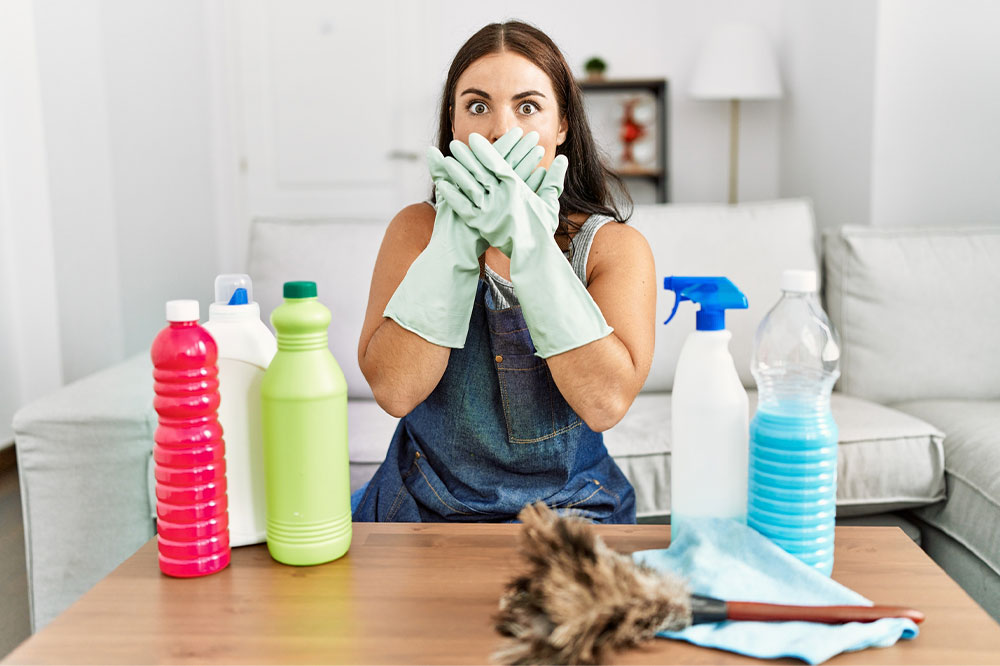Like most tasks, cleaning is something that is learned and perfected gradually. This is why making mistakes is inevitable when one goes about cleaning their house. Moreover, cleaning seems fairly straightforward. So, certain wrong cleaning practices that people have been using for many years may seem fine on the surface. However, such mistakes may cause issues in the long run on the surfaces being cleaned. Some of the most common cleaning mistakes are listed here:
Washing windows on a sunny day
Washing windows may seem like something one could do at any time throughout the day. However, washing them on a bright and sunny day is a bad idea for multiple reasons. For instance, spraying cleaner on dirty windows on a hot and dry day only makes the spray evaporate quickly. This ends up leaving patches and streaks on the window’s glass surface. Such patches may not be visible immediately but can be seen later.
As a result, cleaning windows with sprays on a sunny day will make it necessary to clean them again later. To avoid this tiresome and repetitive process, one can wait until sundown or clean the windows when the weather is cloudy.
One can use effective and reliable cleaners such as Clorox Pine-Sol to clean windows. Pine-sol disinfectants and cleaners have undergone several tests during and after production. This makes them the perfect option for cleaning homes.
Not cleansing surfaces before disinfecting them
This is one of the most repeated mistakes. Usually, many people may not know the difference between cleaning and disinfecting, two terms that have several overlapping aspects but are not the same. Cleaning surfaces physically eliminates most germs. On the other hand, disinfecting involves the use of powerful chemical solutions to kill germs.
However, surfaces need to be cleaned thoroughly before being disinfected. A disinfectant will not be effective on a dirt or dust-covered surface. Cleaning before disinfecting removes dust and dirt. Essentially, chemical-based cleaners, such as the Pine-Sol disinfectant for household cleaning, are more effective on surfaces clear of residue or debris.
Using the same cloth to clean multiple surfaces
Cleaning multiple surfaces with the same cloth transfers germs from one surface to another. While using the same cloth to clean the entire house may make sense, it also results in risky scenarios, such as transferring bacteria from the restroom to the kitchen stove and counter.
The solution is simple – using multiple cloth pieces to clean different surfaces. All these pieces need to be laundered regularly. One can use room spray sanitizers on surfaces also to keep bacteria from festering anywhere. If the cleaner uses disposable disinfectant wipes, they will need to be used once before being discarded.
Using the wrong cleaning products/tools
Certain cleaning products and disinfectants are more effective, less corrosive, and safer than others. So, using “incorrect” products or tools for this purpose can be a massive waste of time. Using such products means that the areas and surfaces one is focusing on are not being properly cleaned. What’s worse, many of them can seriously damage parts of one’s house. For example, any cleaner or disinfectant containing even a small amount of vinegar leaves surfaces permanently corroded.
Some of the best cleaners and products for cleaning, disinfecting, and disposing of waste are Clorox Pine-Sol and Glad ForceFlexPlus with Clorox trash bags.
Using too many products
Using too many products or too much of a single product can oversaturate the materials used for cleanings, such as microfiber cloths or plastic dusters. Instead, it leaves scars on these materials.
As a result of this, people may spend more time trying to clean these materials instead of their windows, furniture, flooring, walls, or other surfaces. To avoid all these problems, one needs to use small amounts of chemicals while cleaning their home.
Using dish soap on wooden cutting boards
Wood tends to have an adverse reaction when it comes in contact with water. Therefore, using soap and warm water on wooden cutting boards must be avoided while cleaning such surfaces. An alternate solution is to soak a chopping board in a bleach solution after one uses it to slice poultry or meat. Soaking the board in bleach prevents cross-contamination before one prepares their next meal.
Spraying direct onto surfaces
While cleaning any surface across one’s home, cleaners must be sprayed onto a cloth before they can be used to wipe the surface clean. Instead of spraying cleaners directly onto a surface, this procedure prevents patches or streaks from showing on these surfaces.
One can hire professionals from renowned agencies such as SERVPRO cleaning services to make the cleaning process organized and seamless. SERVPRO services offer deep cleaning for homes across the country.
Not cleaning the vacuum cleaner
Cleaning the floor or walls with a dirty vacuum will transfer germs from one place to another in one’s house. To avoid that, people can clean their vacuum cleaner components by removing any stuck hair, strings, or fluff from within it. This clears up vacuum blockage and improves the effectiveness of the machine.
Dusting with a dry rag
Dusting surfaces with a rag cloth simply moves dust and dirt around them. Furthermore, contrary to popular belief, dusting with a damp cloth does not necessarily leave a polish or cleaner residue on furniture or other surfaces. One can simply use a damp cloth to pick dust off any surface. Microfiber cloth has been found to be the most effective for this task.
Mixing ammonia and bleach
Mixing different cleaning products is already a bad idea. However, mixing bleach-based products and ammonia-based products is even worse. When vapors from these two chemicals mix, a toxic gas is created. Inhaling this gas can be life-threatening at worst.
In case the two chemicals have been accidentally mixed, one needs to leave their house immediately and call 911 to sort the situation out.



